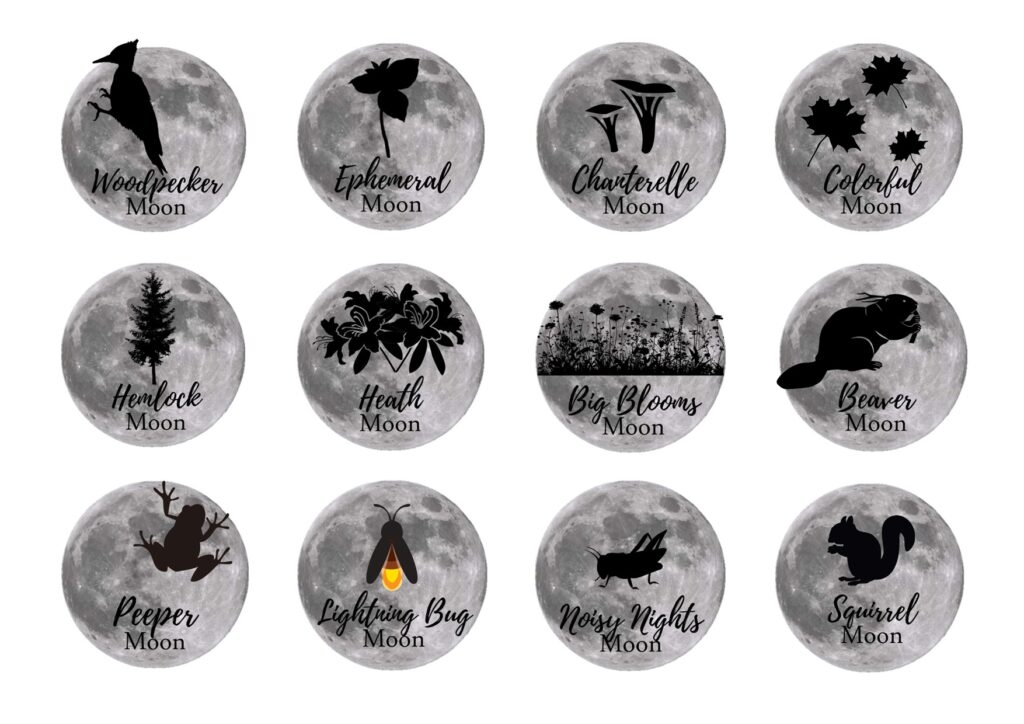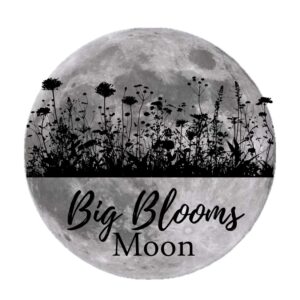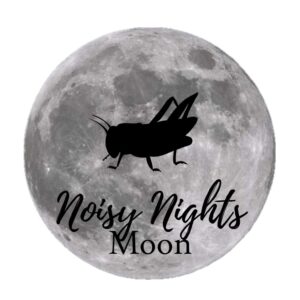
The moon has received a lot of attention since the pandemic with many folks, including us, learning to follow its cycles to practice mindfulness and, ironically, stay grounded. Through our efforts, we found that following the moon is also a great way to gain a deeper understanding of nature and this place we call home.
But using the traditional full moon names as a guide left us wanting. These names were developed hundreds of years ago and describe forests that no longer exist or forests far from our home. So we drew upon our observations from decades of hiking to create moon names that are meaningful to the New River Gorge as we experience it today.
Each moon cycle is a micro-season with its own sounds, sights, and smells. We chose the predominant wonders from each period to represent the full moon. We hope you’ll use this naturalist’s guide to the New River Gorge moons to observe and appreciate these cyclical gifts of nature.

January: Woodpecker Moon
Walking through the forest in January is an exercise in quiet contemplation. The absence of birdsong, crunchy leaves, and noisy insects can leave you feeling alone, even a bit lonely. But don’t be fooled, the forest is still very much alive, and nothing makes that more obvious than the loud echo of a drumming woodpecker. And if you hear the raucous call of a Piliated Woodpecker, YOU will feel more alive, instantly!
These fascinating birds are not only easy to hear but easy to spot. Their bold red, black, and white markings stand in stark contrast to the soft monochrome colors of the January forest. Learning the placement of the colors will help you differentiate which native species you’ve come across in the New River Gorge. Is it a Red-headed, Northern Flicker, Red-bellied, Yellow-bellied, Downy or Hairy?
Full Moon – 1/25/24 | Traditional American Name: Wolf Moon | Other January Forest Finds: Animal Tracks, Frozen Waterfalls, Striped Wintergreen Leaves, Turkey Tail Mushrooms, Barred Owls, The Contours of the Earth

February: Hemlock Moon
A hemlock forest is a very special place and the New River Gorge is full of them. A community of evergreen hemlock trees offers an oasis in the winter forest; they provide shelter from harsh winds and the never-ending winter sky. These tall conifers with their flat feathery needles diffuse sunlight through their canopy that is soft and has an almost blueish tint. It’s enchanting.
A hike into a hemlock forest also makes the devastation of this New River Gorge keystone species impossible to ignore. So many old trees have been taken down by the wooly adelgid (an invasive aphid-like insect) and many more will succumb. Stronger action is needed to prevent their extinction, but developing an appreciation of their presence is a good place to start.
Full Moon – 2/24/24 | Traditional American Name: Snow Moon | Other February Forest Finds: Rock Tripe, Patridge Berries, Scarlet Cup Mushrooms, Red-Tailed Hawks

March: Peeper Moon
A chorus of tiny frogs in the great cathedral of the forest is a sure sign that spring has arrived in the New River Gorge. And while you are unlikely to ever see these little creatures, their voices leave no doubt that they occupy the forest by the hundreds and thousands.
Knowing that their tiny amphibian bodies survived the freezing winter is to understand the ferocity of their song. Spring Peepers rejoice – loudly, and they take up space, albeit more atmospheric than physical. They tell the forest (but more importantly, their potential mates) that they are still back and ready to celebrate!
Full Moon – 3/25/24 | Traditional American Name: Worm Moon | Other March Forest Finds: Skunk Cabbage, Nests of Bald Eaglets, Active Chipmunks, Giant Icicles

April: Ephemeral Moon
Every April, when the forest canopy remains almost as open and leaf-free as in the heart of winter, warm spring sunlight pours onto the forest floor creating the perfect environment for spring ephemerals. These small wildflowers are as varied as they are plentiful, presenting short-lived blooms in every color of the rainbow.
The many bends of the New River and the varied elevations of the surrounding cliffs create numerous microclimates, each accepting the sunlight and prevailing wind in a different way. These microclimates provide hikers with an ever-changing and diverse array of wildflowers. From Spring Beauties to Trout Lilies to Trillium, these beautiful wildflowers are a sight for sore winter eyes.
Full Moon – 4/23/24 | Traditional American Name: Pink Moon | Other April Forest Finds: Morel Mushrooms, Silverbell Tree Blooms, Redbud Tree Blooms, Rattlesnakes and Copperheads (Coming Out of Hibernation), Fiddleheads

May: Heath Moon
While you may not be familiar with the term heath, if you’ve ever visited Appalachia, you are familiar with this family of evergreen shrubs. It includes several different species of rhododendron and Mountain Laurel which fill the understory of the New River Gorge and produce big blooms that dominate the forest.
The May full moon kicks off the trilogy of heath blooms. The bright fuchsia/purple flowers of the Catawba Rhododendron bloom first in mid-late May. They are followed by the bold but intricately detailed pink and white Mountain Laurel blooms and finally, in early summer, the ubiquitous white flowers of the Great Rhododendron (the West Virginia state flower).
Full Moon – 5/23/24 | Traditional American Name: Flower Moon | Other May Forest Finds: Lady Slipper Orchids, Tulip Tree Blooms, Fraser Magnolia Blooms, Wood Ear Mushrooms, Red Efts

June: Lightning Bug Moon
Few experiences are more magical than watching the first lightning bugs of summer gently fly, float really, through the warm evening air. The twinkling of light that scatters throughout the forest surely reminds almost everyone raised in Appalachia of carefree childhood fun.
But there is a lot to learn from observing lightning bugs, or fireflies as they are called elsewhere. For example, you can determine the species (there are several) by watching how high they fly, the color of light they emit, and/or their flash patterns. Did that lil’ guy just let off one, two, or three flashes, and how long did they last?
Full Moon – 6/21/24 | Traditional American Name: Strawberry Moon | Other June Forest Finds: Firepinks, Salamanders, Russula Mushrooms, Ghost Pipes, Maidenhair Ferns

July: Chanterelle Moon
Little patches of yellow-orange mushrooms start popping up after the mid-summer rains dampen the forest floor, and they grow gregariously in many different forest communities. These chanterelle mushrooms can look more like sturdy flower blossoms than spongy toadstools, but they are definitely a fungus.
While less mysterious than morel mushrooms, chanterelles are no less delicious. And their reliable abundance seems to encourage human enjoyment without enacting human greed. Once adequately studied, these mushrooms are easy to identify and fun to forage, making each trip into the July forest a tasteful curation of tonight’s dinner.
Full Moon – 7/21/24 | Traditional American Name: Buck Moon | Other July Forest Finds: Ripe Blackberries, Sourwood Tree Blooms, Rattlesnake Orchid Blooms, White-tailed Deer in Velvet, Bolete Mushrooms

August: Big Blooms Moon
In many ways, fall wildflowers are the exact opposite of spring wildflowers. Fall blooms are huge – standing up to six feet taller than their spring counterparts. And they aren’t shy – growing along highly visible roadsides, fencelines, and under powerline cuts instead of hidden on the forest floor.
Of course, all wildflowers are simply seeking light and have very little concern for our viewing pleasure, but boy do they provide pleasure. Every August in the New River Gorge, Joe Pye Weed leads the fall wildflower season with its huge pinkish-purple blooms. It’s followed by other statuesque wildflowers like bright purple ironweed, (uncommonly beautiful) common milkweed, and a litany of yellow blooms including wingstem and goldenrod.
Full Moon – 8/19/24 (Super Blue Moon) | Traditional American Name: Sturgeon Moon | Other August Forest Finds: Cardinal Flowers, Milky Mushrooms, Jewelweed, Black Trumpet Mushrooms, Moths

September: Noisy Nights Moon
Crickets, katydids, and cicadas each have their own rhythms, and sometimes one species seems to play harmony or even melody for the others. To sit in the September forest at dusk is like attending a symphony with well-tuned acoustics. It’s a good show and over too soon.
The noisy late summer insects make their signature sounds differently. None use their mouths. Male crickets rub their leathery, serrated front wings together. Male and female katydids rub the sharp edge of one wing against the file-like ridge of the other wing. Male cicadas expand and contract a membrane under their wings called a tymbal.
Full Moon – 9/18/24 (Super Moon) | Traditional American Name: Harvest Moon | Other September Forest Finds: Spicebush Berries, Pawpaw Fruit, Hedgehog Mushrooms, Giant Puffballs

October: Colorful Moon
So much is happening in the October forest: the dead leaf litter comes alive with small critters, big mushrooms surround and climb trees, and crows dominate the sky. But all this takes a back seat to the colorful magic that’s happening in the forest canopy. The leaves are changing.
As the nights get longer and chlorophyll leaves the leaves of our many deciduous trees, their underlying colors shine through for a short but magnificent show. Red, russet, bronze, gold, yellow, purple, red, crimson, scarlet, and orange are revealed throughout the New River Gorge. People come from far and wide to view the spectacle and celebrate the magic.
Full Moon – 10/17/24 (Super Moon) | Traditional American Name: Hunter’s Moon | Other October Forest Finds: Hen-of-the-Woods Mushrooms, Shrimp-of-the-Woods Mushrooms, Chicken-of-the-Woods Mushrooms, Falling Black Walnuts

November: Beaver Moon
Have you ever wondered what the inside of a beaver lodge looks like? They are undoubtedly cozy. Sometimes you can even see steam rising from the roof vents on a cold winter day. Goodness knows the beavers spent a great deal of time and energy constructing their homes and preparing them for winter, and this is never more evident than in November.
When the days and the water turn cold, the beavers spring into action making repairs to both lodges and dams and gathering food for their underwater cold storage. With the right preparation, they can live comfortably under frozen ponds, creeks, and lakes by accessing underwater trails to their home and work.
Full Moon – 11/15/24 (Super Moon) | Traditional American Name: Beaver Moon | Other November Forest Finds: Witch Hazel Blooms, Turkeys, Enoki Mushrooms, Ripe Sumac Drupes, Vulture Trees

December: Squirrel Moon
It’s easy to overlook the wonder of squirrels. To most of us, they are ubiquitous, living in our neighborhoods, cities, and forests. Sometimes in the tree right outside our bedroom window. Squirrels and humans live parallel lives, occasionally overlapping in the presence of peanuts or highways.
Most of us lose our fascination with these fuzzy creatures after we’ve spent only five years on the planet. But to watch, really watch, a squirrel in the December forest of the New River Gorge is to regain an appreciation of these amazing little acrobats. Surely no other creature knows our woods better. They bound across the forest floor, scale even the highest trees, and tuck their winter supply of nuts in every nook and cranny along the way.
Full Moon – 12/15/24 | Traditional American Name: Cold Moon | Other December Forest Finds: Putty Root Orchid Leaves, Oyster Mushrooms, Holly Berries, Christmas Ferns, Rhodo Tunnels
While it’s always important to be respectful of the forest and “leave no trace,” it is particularly important in our National Parks. If you have questions about the specific rules for foraging in the New River Gorge National Park and Preserve, review the Superintendent’s Compendium.
Who are we? Amy & Shawn, New River Gorge hikers, WV Master Naturalists, and owners of Lafayette Flats Boutique Vacation Rentals in downtown Fayetteville, WV in the heart of the New River Gorge National Park.
Craving more data for your New River Gorge getaway? Learn more about enjoying nature in the New River Gorge and New River Gorge Eco Tours: Guided Forest Walks.
